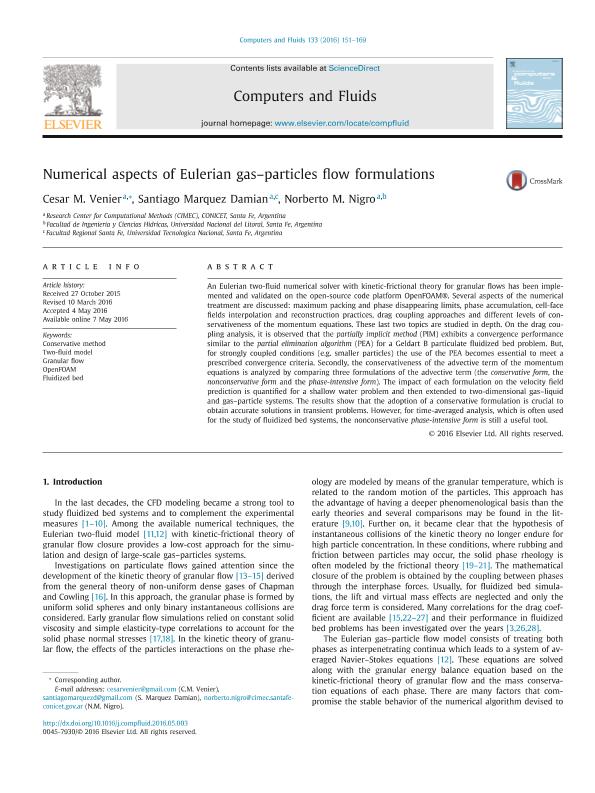Mostrar el registro sencillo del ítem
dc.contributor.author
Venier, César Martín

dc.contributor.author
Marquez Damian, Santiago

dc.contributor.author
Nigro, Norberto Marcelo

dc.date.available
2018-03-07T21:14:03Z
dc.date.issued
2016-07
dc.identifier.citation
Venier, César Martín; Marquez Damian, Santiago; Nigro, Norberto Marcelo; Numerical aspects of Eulerian gas-particles flow formulations; Pergamon-Elsevier Science Ltd; Computers & Fluids; 133; 7-2016; 151-169
dc.identifier.issn
0045-7930
dc.identifier.uri
http://hdl.handle.net/11336/38224
dc.description.abstract
An Eulerian two-fluid numerical solver with kinetic-frictional theory for granular flows has been implemented and validated on the open-source code platform OpenFOAM®. Several aspects of the numerical treatment are discussed: maximum packing and phase disappearing limits, phase accumulation, cell-face fields interpolation and reconstruction practices, drag coupling approaches and different levels of conservativeness of the momentum equations. These last two topics are studied in depth. On the drag coupling analysis, it is observed that the partially implicit method (PIM) exhibits a convergence performance similar to the partial elimination algorithm (PEA) for a Geldart B particulate fluidized bed problem. But, for strongly coupled conditions (e.g. smaller particles) the use of the PEA becomes essential to meet a prescribed convergence criteria. Secondly, the conservativeness of the advective term of the momentum equations is analyzed by comparing three formulations of the advective term (the conservative form, the nonconservative form and the phase-intensive form). The impact of each formulation on the velocity field prediction is quantified for a shallow water problem and then extended to two-dimensional gas-liquid and gas-particle systems. The results show that the adoption of a conservative formulation is crucial to obtain accurate solutions in transient problems. However, for time-averaged analysis, which is often used for the study of fluidized bed systems, the nonconservative phase-intensive form is still a useful tool.
dc.format
application/pdf
dc.language.iso
eng
dc.publisher
Pergamon-Elsevier Science Ltd

dc.rights
info:eu-repo/semantics/openAccess
dc.rights.uri
https://creativecommons.org/licenses/by-nc-sa/2.5/ar/
dc.subject
Conservative Method
dc.subject
Fluidized Bed
dc.subject
Granular Flow
dc.subject
Openfoam
dc.subject
Two-Fluid Model
dc.subject.classification
Ingeniería Mecánica

dc.subject.classification
Ingeniería Mecánica

dc.subject.classification
INGENIERÍAS Y TECNOLOGÍAS

dc.title
Numerical aspects of Eulerian gas-particles flow formulations
dc.type
info:eu-repo/semantics/article
dc.type
info:ar-repo/semantics/artículo
dc.type
info:eu-repo/semantics/publishedVersion
dc.date.updated
2018-03-07T15:54:32Z
dc.journal.volume
133
dc.journal.pagination
151-169
dc.journal.pais
Estados Unidos

dc.description.fil
Fil: Venier, César Martín. Consejo Nacional de Investigaciones Científicas y Técnicas. Centro Científico Tecnológico Conicet - Santa Fe. Centro de Investigaciones en Métodos Computacionales. Universidad Nacional del Litoral. Centro de Investigaciones en Métodos Computacionales; Argentina
dc.description.fil
Fil: Marquez Damian, Santiago. Consejo Nacional de Investigaciones Científicas y Técnicas. Centro Científico Tecnológico Conicet - Santa Fe. Centro de Investigaciones en Métodos Computacionales. Universidad Nacional del Litoral. Centro de Investigaciones en Métodos Computacionales; Argentina. Universidad Tecnológica Nacional; Argentina
dc.description.fil
Fil: Nigro, Norberto Marcelo. Consejo Nacional de Investigaciones Científicas y Técnicas. Centro Científico Tecnológico Conicet - Santa Fe. Centro de Investigaciones en Métodos Computacionales. Universidad Nacional del Litoral. Centro de Investigaciones en Métodos Computacionales; Argentina. Universidad Nacional del Litoral. Facultad de Ingeniería y Ciencias Hídricas; Argentina
dc.journal.title
Computers & Fluids

dc.relation.alternativeid
info:eu-repo/semantics/altIdentifier/url/http://www.sciencedirect.com/science/article/pii/S0045793016301438
dc.relation.alternativeid
info:eu-repo/semantics/altIdentifier/doi/http://dx.doi.org/10.1016/j.compfluid.2016.05.003
Archivos asociados
